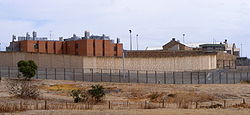
HM Prison Pentridge was an Australian prison that was first established in 1851 in Coburg, Victoria. The first prisoners arrived in 1851. The prison officially closed on 1 May 1997.
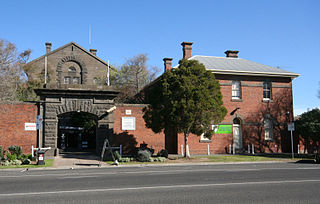
HM Prison Geelong was a maximum security Australia prison located on the corner of Myers Street and Swanston Street in Geelong, Victoria, Australia. The prison was built in stages from 1849 to 1864. Its panopticon design is based on Pentonville Prison in England. The prison was officially closed in 1991 and prisoners were moved to the newly built HM Prison Barwon in Lara. The building now functions as a museum for the history of the prison.

The Old Melbourne Gaol is a former jail and current museum on Russell Street, in Melbourne, Victoria, Australia. It consists of a bluestone building and courtyard, and is located next to the old City Police Watch House and City Courts buildings, and opposite the Russell Street Police Headquarters. It was first constructed starting in 1839, and during its operation as a prison between 1845 and 1924, it held and executed some of Australia's most notorious criminals, including bushranger Ned Kelly and serial killer Frederick Bailey Deeming. In total, 133 people were executed by hanging. Though it was used briefly during World War II, it formally ceased operating as a prison in 1924; with parts of the jail being incorporated into the RMIT University, and the rest becoming a museum.

Risdon Prison Complex is an Australian medium to maximum security prison for males located in Risdon Vale near Hobart, Tasmania. The facility is operated by the Tasmanian Prison Service, an agency of the Department of Justice of the Government of Tasmania. The facility accepts criminals convicted under Tasmanian and/or Commonwealth legislation.

The former Grafton Gaol, later called the Grafton Correctional Centre and then Grafton Intake and Transient Centre is a heritage-listed former medium security prison for males and females, located in Grafton, Clarence Valley Council, New South Wales, Australia. The centre was operated by Corrective Services NSW an agency of the Department of Attorney General and Justice of the Government of New South Wales. In its last correctional use, the centre detained sentenced and remand prisoners under New South Wales and/or Commonwealth legislation. It was added to the New South Wales State Heritage Register on 2 April 1999.

The Goulburn Correctional Centre, is an Australian supermaximum security prison for males. It is located in Goulburn, New South Wales, three kilometres north-east of the central business district. The facility is operated by Corrective Services NSW. The Complex accepts prisoners charged and convicted under New South Wales and/or Commonwealth legislation and serves as a reception prison for Southern New South Wales, and, in some cases, for inmates from the Australian Capital Territory.

H.M. Gaol Hobart or Campbell Street Gaol, a former Australian maximum security prison for males and females, was located in Hobart, Tasmania. Built by convict labour, the gaol operated between 1821 until the early 1960s. In 1961, male inmates were transferred to the H.M. Risdon Prison and in 1963, female inmates were transferred to the Risdon Women's Prison.
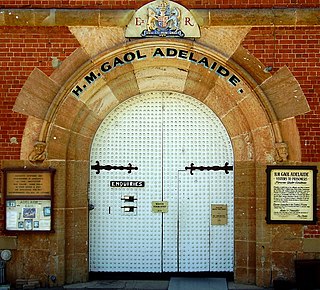
Adelaide Gaol is a former Australian prison located in the Park Lands of Adelaide, in the state of South Australia. The gaol was the first permanent one in South Australia and operated from 1841 until 1988. The Gaol is one of the two oldest buildings still standing in South Australia, the other being Government House which was built at the same time. The prison is now a museum, tourist attraction and function centre.
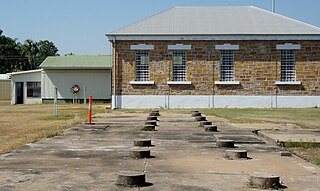
Fannie Bay Gaol is a historic gaol in Fannie Bay, Northern Territory, Australia. The gaol operated as Her Majesty's Gaol and Labour Prison, from 20 September 1883 until 1 September 1979.
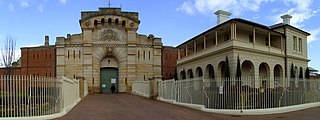
Bathurst Correctional Centre, originally built as Bathurst Gaol in 1888, is a prison for men and women located in the city of Bathurst, New South Wales, Australia, and operated by the Department of Communities and Justice. Bathurst holds inmates sentenced under State or Australian criminal law, along with a small number of remand prisoners.

The Old Maitland Gaol, also known as Maitland Correctional Centre, is a heritage-listed former Australian prison located in East Maitland, New South Wales. Its construction was started in 1844 and prisoners first entered the gaol in 1848. By the time of its closure, on 31 January 1998, it had become the longest continuously-run gaol in Australia. It has since been turned into a museum and is a popular tourist attraction. It was added to the New South Wales State Heritage Register on 2 April 1999.

A super-maximum security (supermax) or administrative maximum (ADX) prison is a "control-unit" prison, or a unit within prisons, which represents the most secure level of custody in the prison systems of certain countries.

The Berrima Correctional Centre was an Australian prison, located at Berrima, New South Wales. The Centre was operational between 1839 and 2011 with a number of breaks in between, was re-opened in September 2016 and then permanently closed in 2020. Initially established as Berrima Gaol, the facility closed in 1909 and reopened in 1949 as the Berrima Training Centre. The Centre was the oldest Australian correctional facility in operation. It was added to the New South Wales State Heritage Register on 2 April 1999.
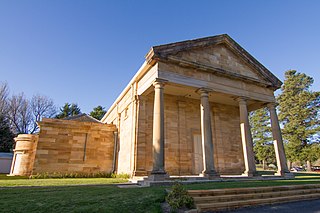
Berrima is a historic village in the Southern Highlands of New South Wales, Australia, in Wingecarribee Shire. The village, once a major town, is located on the Old Hume Highway between Sydney and Canberra. It was previously known officially as the Town of Berrima. It is close to the three major towns of the Southern Highlands: Mittagong, Bowral and Moss Vale.
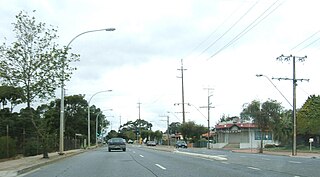
Northfield is a suburb of the greater Adelaide, South Australia area.

The Richmond Gaol is a convict era building and tourist attraction in Richmond, Tasmania, and is the oldest intact gaol in Australia. Building of the gaol commenced in 1825, and predates the establishment of the penal colony at Port Arthur in 1833. One of the tasks completed by the convicts who were held at Richmond Gaol was the construction of Richmond Bridge.

The Northfield railway line was a railway in northern Adelaide running Dry Creek and Northfield. The line branched east from the Gawler railway line just north of Dry Creek station. In earlier years, it saw mixed freight including livestock in and meat out of the Gepps Cross abattoirs and sale yards. In its later years, it was operated as part of the metropolitan passenger rail network and served three stations: Cavan, Pooraka, and Northfield.
The District Council of Yatala was a local government area of South Australia established in 1853 and abolished in 1868.

Dry Creek or Dry Creek Drain is a seasonal stream in South Australia which passes through the Adelaide suburbs of Wynn Vale, Modbury, Walkley Heights and Pooraka. The nearby suburb of Dry Creek and Dry Creek railway station are named after the stream.
The Stockade railway station, the terminal station of the then Stockade railway line, was opened on 1 June 1857. It was built to service the colony's prisoner camp, and to transport bluestone mined by convicts to building projects in downtown Adelaide. After a century of service, it was closed in 1961, and the quarry area was later redeveloped as a park.
